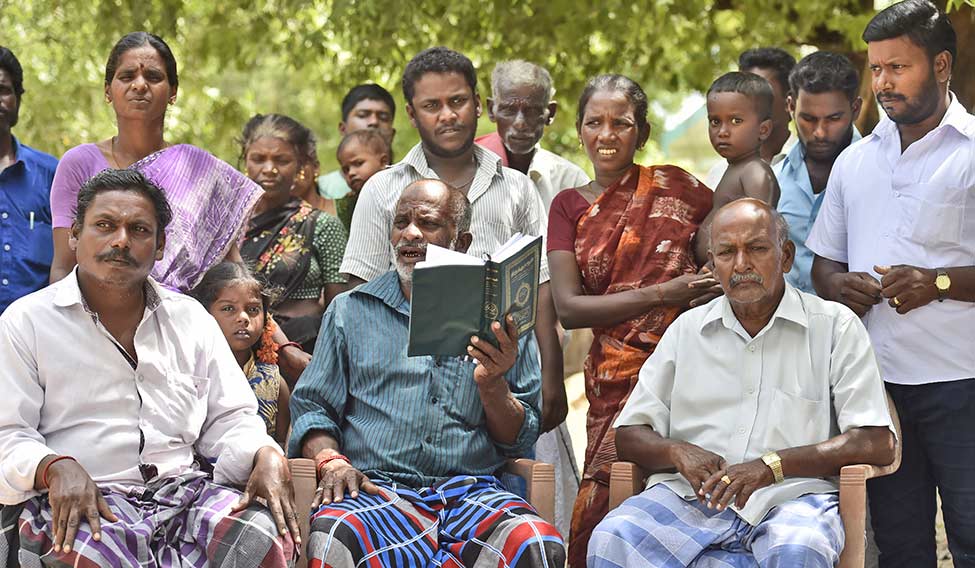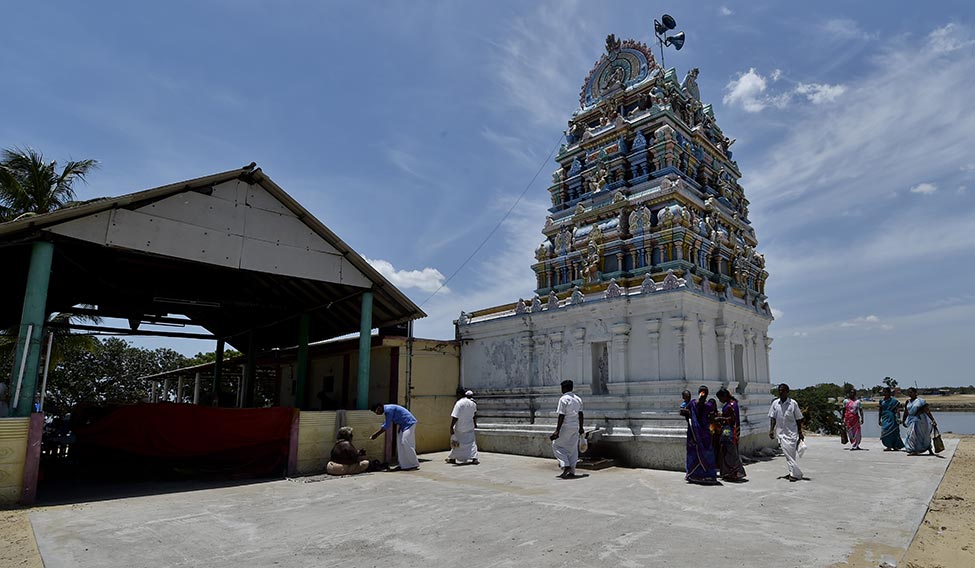The narrow road that leads to coastal Nagapattinam is flanked by barren paddy fields, where scrawny people, their heads covered with mucky towels that were once white in colour, tend to their cattle. Forty kilometres off Nagapattinam is the nondescript Badrakali (goddess Durga) Amman temple, where 600 families from 18 villages come for spiritual solace. Located on the banks of a lake that has long since gone dry, the temple hit headlines recently when 180 dalit families in Pazhangkallimedu, one of the two big villages in the neighbourhood, threatened to embrace Islam as they were denied permission to perform rituals at the five-day festival during the Tamil holy month of Aadi (July-August). On August 9, the temple was again in the news when the Madurai bench of the Madras High Court observed that a compromise had been worked out, which would allow the festival to be conducted without any hitch from 2017.
Though dalits are allowed to worship, they cannot perform the Mandagappadi (rituals) during the annual festival. While the rituals in the first and last days are led by the state government (the temple is under the Hindu Religious and Charitable Endowments Department), in the intervening three days it is the caste Hindus (mainly Pillaimars) of Kallimedu and Thamaraipulam who perform the rituals.

“We want to perform the Mandagappadi,” says Nagappan, who represents the dalits in the peace committee. “Our forefathers were slaves doing menial jobs. Now we are educated like others. There are doctors and engineers from our community. I wish the next generation gets all the rights and does not face any discrimination.” After several rounds of peace talks, police and government interventions, says Nagappan, “we have decided to embrace Islam, because there is no caste difference in it”.
The caste Hindus are willing to allow dalits to lead the rituals in a separate festival, but the dalit families insist that they lead the rituals at least on one of the five days during the Aadi festival. Already six dalit families have converted to Islam, as the petitions before the collector have yielded no response. The government’s peace committee, comprising the representatives of caste Hindus and dalits, temple authorities, police and the collector, has met at least five times to resolve the issue. Manoazhagan, a temple representative, blames it on the ego of both the communities. “The OBCs are willing to allow the dalits to perform the rituals during the day, in any one of the five days,” he says. “But they want it for one full day. The peace talks are not making any headway. The collector will soon submit his report in the court and it will decide the next course of action.”
Pazhangkallimedu is not an exception. Nearly 240km away, at Nagappalli village in Karur district, 70 dalit families are planning to embrace Islam. The reason: their fight to retain the rights in their own Sri Mahasakthi Mariamman temple, built seven years ago, has not yielded any result. “There are many temples in our village,” says P. Vetrivel, president of the temple trust. “Since we could not go freely into the other temples, we built one for ourselves, on our own land. For the past two years, caste Hindu families who came back from Sri Lanka are claiming rights and denying us entry.” Today, the temple is deserted. Built in 2009 with Rs 25,000 from the government, a trust run by dalits was managing the temple. While the OBCs—mainly the Gounders and those from the Kongu community—claim rights, as they have contributed to the building of the temple, the dalit groups have ensured that community interests are not documented. The image of Mariamman painted on one of the side walls once had the name of the donor with his community. “We have erased the community name,” says Vetrivel. Two years after the row erupted, the temple is home to stray dogs, thanks to a broken gate that allows free passage.
Dalit struggle for equal share of honour in temples is not new in Tamil Nadu. In 1998, the famous Kandadevi temple car in Sivaganga district was set on fire as the Devendira Kula Vellalars (a section of dalits) were denied permission to pull it. Several petitions in the High Court and protests later, 26 dalit families were allowed to take part in the pulling of the car in 2005. Since then, the car, apparently, has been under repair. Way back in 1934, Mahatma Gandhi had tried to broker peace between the caste Hindus and dalits here in vain. Comparing the rows in Nagappalli and Kallimedu with Kandadevi might be far-fetched but discrimination lies at the heart of the disputes.
Caste discrimination is rearing its ugly head in temples of learning as well. On August 8, five dalit children, including a girl, all under the age of nine, were booked under the Protection of Children from Sexual Offences (POCSO) Act, in a village near Madurai, for allegedly harassing children from the dominant Thevar community. The clash took place when a Thevar student mocked the dalit children using a nickname. The dalits threatened to pelt stones, which led to arguments and a minor scuffle. The clash carried over to the school as parents of the Thevar children came to inquire about the dalit children. Using the influence of a Thevar MLA, the parents filed a petition with the police. Though the issue has been resolved for now and the dalit children are out of jail, the fact remains that the school always had two dining rooms—one for the dalits and the other for non-dalits. Even the floor mats, tumblers and plates are separate for dalit children. “The allegations [against the dalit students] are baseless. The case has to be withdrawn,” says A. Kathir of Evidence, a human rights organisation based in Madurai.
 Kausalya
Kausalya
In south and west Tamil Nadu, caste education comes before science and languages. Students in Gopalasamudram village near Tirunelveli wear different coloured threads on their wrists signifying caste identity. The Thevars wear red and yellow threads, the Nadars blue and yellow, and the Yadavs saffron. Apparently, it helps the students identify potential friends. For the Pallars (dalits) it is green and red, and for the Arundhathiyars (a dalit sub-sect), it is black and white. Following caste clashes and arguments in schools, the Tirunelveli district administration issued an oral order banning the colour threads. It did not work because it was argued that the threads were sacred, given in temples.
Says Ramalingam Rajan, a retired school teacher from Tirunelveli region: “Even the colour of the vests the students wear differs according to their community.” According to him, students wear lockets tied in coloured threads around their neck, which have photographs of their caste leaders. For instance, the Thevars wear lockets with photos of the late Forward Bloc leader U. Muthuramalinga Thevar, the Nadars of the late Congress leader K. Kamaraj, and the Yadavs of freedom fighter Veeran Alagumuthu Kone. In west Tamil Nadu—Coimbatore, Erode and Namakkal—the Gounders wear lockets with the pictures of Dheeran Chinnamalai, one of the commanders of the Polygar Wars during the 1800s.
OBC politics is deep-rooted in south and west Tamil Nadu, and many small caste-based outfits start the indoctrination quite early. Sources in Thiruchengode, near Erode, claim that Yuvaraj, a leader of the Dheeran Chinnamalai Gounder Peravai, who was arrested in connection with the murder of the dalit youth Gokulraj, used to visit schools to tell students about the Kongu Vellala Gounders and their culture. Gounders are the dominant caste in Coimbatore, Tiruppur, Erode, Salem, Thirucehngode and Namakkal, classified as backward caste within the 69 per cent reservation quota in Tamil Nadu. While the Vanniyars have the upper hand in the north, the Thevars and the Nadars dominate south Tamil Nadu. “These OBCs call themselves the Aanda Parambarai, meaning the ruling class,” says Kathir. “But whom did they rule? It is only the dalits or the oppressed community.”
Caste consciousness in the western belt is such that writer Perumal Murugan was made to quit writing for his novel Maadhorubhagan (One Part Woman). Caste outfits and hindutva groups in Namakkal and Thiruchengode alleged that he had demeaned Lord Arthanareeswarar (half man, half woman) through his novel. “Every region in Tamil Nadu has been dominated by a particular caste,” says dalit writer Stalin Rajangam. “Now they want an emotional issue to retain their power. The result: temple rows, honour killings and violence against the dalits.”
 Determined: Dalit families in Pazhang-kallimedu, who have converted to Islam.
Determined: Dalit families in Pazhang-kallimedu, who have converted to Islam.
The murder of dalit engineering graduate Shankar in the Udumalpet market, in broad daylight in March this year, proves the point. Shankar had fallen in love with a caste Hindu girl and married her. In fact, says Kathir, the killing of Shankar was to warn dalits in the region to not fall in love with caste Hindu girls. But Shankar’s widow, Kausalya, is determined to take care of his family. “Why should I leave them?” she asks. “My parents are in jail. They wanted to ensure that I leave Shankar and live with them. I am determined to work for victims like me, who are hounded by caste.” Months later, the government has extended support to Kausalya by way of a monthly pension of Rs 11,600.
Shankar’s murder brought back into spotlight the killing of dalit youth Ilavarasan, in Dharmapuri, in 2012. Ilavarasan had married Divya, a Vanniyar girl from a neighbouring village, triggering caste violence. Four years later, normal life is back in the dalit colonies of Natham, Anna Nagar, Kondampatti, Maravadi and Vellalapatti. But the scars remain. “It is the combination of socio-economic factors that fuels the animosity between the OBCs and dalits,” says Stalin. The OBCs are always looked at as the powerful ruling class with a sizeable vote bank.
According to Kathir, the animosity between the sides has been building up because of the reverse of the gap in socio-economic conditions. Dalit youths in Dharmapuri had found jobs, be it menial or big, in cities like Bengaluru and Chennai. But the OBC Vanniyars have not been able to leave their agriculture lands, which have turned either barren or unyielding over the years. The dalits, reaping the dividends of reservation, have moved up the socio-economic ladder. Says Kathir: “When dalits focus on studies, find jobs and earn better than their men, the OBC women find the dalit youths more promising. In most cases, this leads to the violence.”








